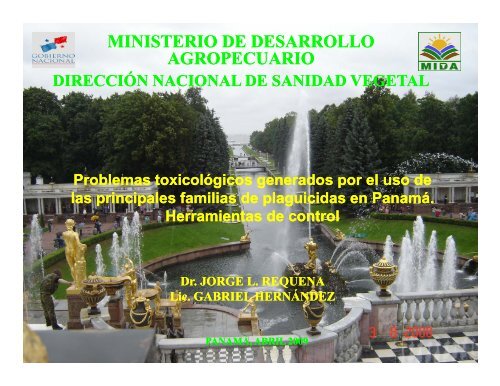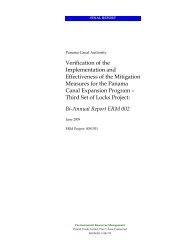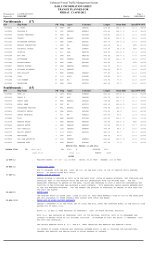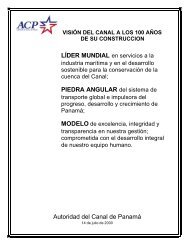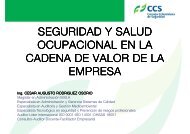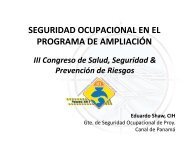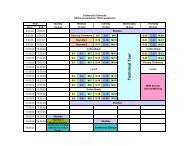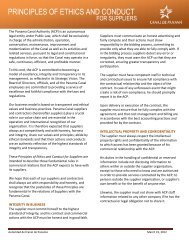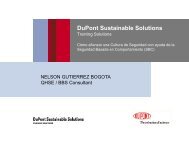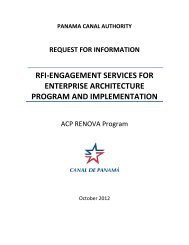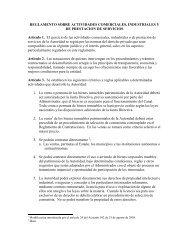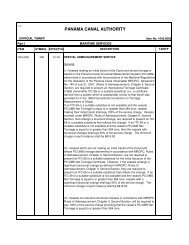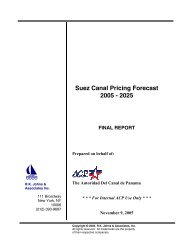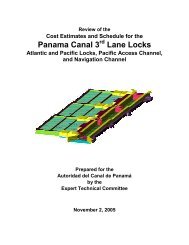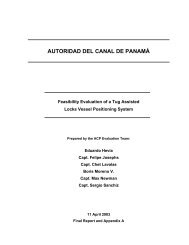Problemas toxicológicos generados por el uso de ... - Panama Canal
Problemas toxicológicos generados por el uso de ... - Panama Canal
Problemas toxicológicos generados por el uso de ... - Panama Canal
You also want an ePaper? Increase the reach of your titles
YUMPU automatically turns print PDFs into web optimized ePapers that Google loves.
MINISTERIO DE DESARROLLO<br />
AGROPECUARIO<br />
DIRECCIÓN NACIONAL DE SANIDAD VEGETAL<br />
<strong>Problemas</strong> toxicológicos <strong>generados</strong> <strong>por</strong> <strong>el</strong> <strong>uso</strong> <strong>de</strong><br />
las principales familias <strong>de</strong> plaguicidas en Panamá.<br />
Herramientas <strong>de</strong> control<br />
Dr. JORGE L. REQUENA<br />
Lic. GABRIEL HERNÁNDEZ<br />
PANAMÁ, ABRIL 2009
INTRODUCCIÓN<br />
<strong>Problemas</strong> <strong>de</strong> salud ocupacional<br />
Fertilizantes y plaguicidas.<br />
Los plaguicidas seguirán siendo un factor clave en la<br />
p g g<br />
producción agrícola. Sin embargo, mal empleados, conducen<br />
irremediablemente a problemas <strong>de</strong> salud ocupacional,<br />
contaminación <strong>de</strong> los alimentos y al <strong>de</strong>terioro d<strong>el</strong> ambiente.
INTRODUCCIÓN<br />
• Uno <strong>de</strong> los primeros re<strong>por</strong>tes <strong>de</strong> intoxicaciones<br />
producidos en humanos, bien documentado, <strong>por</strong><br />
plaguicidas en Panamá se dió <strong>por</strong> <strong>el</strong> <strong>uso</strong> d<strong>el</strong><br />
herbicida arseniato <strong>de</strong> plomo, usado para <strong>el</strong><br />
control <strong>de</strong> la vegetación acuática en <strong>el</strong> Lago<br />
Gatún, durante <strong>el</strong> periodo 1914 – 1935.
¿QUÉ ES UN PLAGUICIDA?<br />
PRODUCTO FORMULADO CON ACTIVIDAD BIÓTICA<br />
QUE SE USA EN LA PROTECCIÓN DE PLANTAS<br />
CULTIVADAS, ENTRE OTROS PARA EL CONTROL DE<br />
PLAGAS (INSECTOS, ENFERMEDADES, PARÁSITOS,<br />
MALEZAS). VEAMOS<br />
LA SIGUIENTE<br />
CLASIFICACIÓN:<br />
CLASIFICACIÓN PRÁCTICA DE LOS PLAGUICIDAS<br />
CLASE<br />
INSECTICIDA<br />
FUNGICIDAS<br />
HERBICIDAS<br />
FAMILIA<br />
ORGANOFOSFORADOS, CARBAMATOS<br />
DITIOCARBAMATOS, TRIAZOLES<br />
CLOROFENOXI, BIPIRIDILOS
¿CUÁNTO SE USA DE PLAGUICIDAS<br />
EN PANAMÁ?<br />
60,000,000<br />
50,000,000<br />
40,000,000<br />
30,000,000<br />
20,000,000<br />
10,000,000<br />
0<br />
PLAGUICIDAS FERTILIZANTES ADITIVOS<br />
2005 5,833,738 35,490,536 536 4011333 4,011,333<br />
2006 5,570,375 55,038,692 3,817,363<br />
2007 7,221,628 43,966,494 3,101,792<br />
La actividad agrícola en Panamá consume alre<strong>de</strong>dor d<strong>el</strong><br />
90% <strong>de</strong> los plaguicidas que ingresan al país.
IMPORTACIÓN DE PLAGUICIDAS POR CLASE 2005 - 2007<br />
4,000,000<br />
3,500,000<br />
3,000,000<br />
2,500,000<br />
2,000,000<br />
1,500,000<br />
1,000,000<br />
500,000<br />
0<br />
2005 2006 2007<br />
HERBICIDAS 3,133,847 2,962,262 3,743,356<br />
2,500,000<br />
2,000,000<br />
1,500,000<br />
1,000,000<br />
500,000<br />
0<br />
AÑO 2005 AÑO 2006 AÑO 2007<br />
INSECTICIDAS 1,483,556 1,274,957 2,009,449<br />
1,500,000<br />
1,450,000<br />
1,400,000<br />
1,350,000<br />
000<br />
1,300,000<br />
1,250,000<br />
1,200,000<br />
1,150,000<br />
1,100,000<br />
2005 2006 2007<br />
FUNGICIDAS 1,231,860 1,335,361 1,468,824
VOLUMEN DE PRINCIPALES FAMILIAS IMPORTADAS AL PAÍS<br />
ORGANOFOSFORADOS<br />
CARBAMATOS<br />
1,500,000<br />
1,034,528 854,680<br />
1,274,473<br />
500,000<br />
451,885<br />
kg.<br />
1,000,000<br />
500,000<br />
400,000000<br />
300,000<br />
Kg.<br />
200,000<br />
13 4 ,3 76<br />
14 8 ,4 79<br />
0<br />
100,000<br />
2005 2006 2007 0<br />
2005 2006 2007<br />
DITIOCARBAMATOS<br />
BIPIRIDILOS<br />
901,359<br />
1000 1,000,000<br />
632,893 643,020<br />
400,000000<br />
800,000<br />
300,000<br />
600,000<br />
Kg. Kg. 200,000<br />
400,000<br />
200,000<br />
100,000<br />
266,283 247,327<br />
360,058<br />
0<br />
2005 2006 2007<br />
0<br />
2005 2006 2007
PRINCIPALES INGREDIENTES ACTIVOS IMPORTADOS<br />
Promedio herbicidas im<strong>por</strong>tados 2005-2007<br />
1,400,000<br />
1,285,470<br />
1,200,000<br />
Kg<br />
1,000,000<br />
800,000<br />
600,000<br />
400,000<br />
277,177<br />
637,907<br />
200,000<br />
0<br />
GLIFOSATO PARAQUAT 2,4-D<br />
Insecticidas im<strong>por</strong>tados en kg., 2005-2007<br />
Promedio fungicidas im<strong>por</strong>tados 2005-2007<br />
,CARBOFURAN<br />
16 1,79 5<br />
800,000<br />
700,000<br />
600,000<br />
712,195<br />
500,000<br />
Kg<br />
400,000<br />
300,000<br />
,TERBUFOS<br />
416,547<br />
,ETOPROFOS<br />
53,204<br />
200,000<br />
10 0 ,0 0 0<br />
0<br />
37,906<br />
114 ,79 1<br />
CLOROTALONIL M ANCOZEB TRIDEM ORF
CATEGORÍA<br />
CLASIFICACIÓN DE PLAGUICIDAS AGRÍCOLAS<br />
POR SU PELIGROSIDAD - OMS<br />
DL 50 AGUDA<br />
PICTOGRAMA FRASE DE COLOR POR VÍA ORAL VÍA CUTÁNEA<br />
ADVERTENCIA<br />
SÓLIDO LÍQUIDO SÓLIDO LÍQUIDO<br />
1a/1 Extremadamente p<strong>el</strong>igroso Muy tóxico < 5 < 20 < 10 < 40<br />
Ib/2 Altamente p<strong>el</strong>igroso Tóxico > 5 - 50 >20 - 200 >10 -100 >40 - 400<br />
II/3 Mo<strong>de</strong>radamente p<strong>el</strong>igroso Dañino >50 - 500 >200 - 2000 >100 -1000 >400 - 4000<br />
III/4 Ligeramente p<strong>el</strong>igroso Cuidado >500 - 2000 >2000 - 3000 Más <strong>de</strong> 1000 Más <strong>de</strong> 4000<br />
IV/5 Precaución Más <strong>de</strong> 3000<br />
Las cantida<strong>de</strong>s están expresadas en mg/kg <strong>de</strong> peso vivo
FACTORES QUE DETERMINAN LA<br />
TOXICOLOGÍA DE PLAGUICIDAS<br />
• Las cantida<strong>de</strong>s d (dosis).<br />
• El tiempo (duración a la<br />
exposición). iió)<br />
• Vías <strong>de</strong> penetración.<br />
• La forma y estructura <strong>de</strong> la<br />
sustancia química misma.<br />
• Los factores genéticos<br />
individuales.
EFECTO DE LOS PLAGUICIDAS EN LA<br />
SALUD (1980 – 1990)<br />
• Se <strong>de</strong>positan<br />
principalmente en <strong>el</strong><br />
tejido graso, en menor<br />
cantidad en hígado,<br />
músculos, bazo y<br />
sangre.<br />
• La exposición laboral<br />
es la causa más<br />
im<strong>por</strong>tante<br />
<strong>de</strong><br />
intoxicaciones.<br />
• El grado <strong>de</strong> absorción<br />
d<strong>el</strong> químico es variable:<br />
35% <strong>por</strong> <strong>el</strong> cráneo,<br />
40% <strong>por</strong> frente, 50%<br />
<strong>por</strong> <strong>el</strong> oído, 99% <strong>por</strong> <strong>el</strong><br />
escroto.<br />
PAÍS/AÑO/TIPO<br />
REGISTRO<br />
LABORAL,<br />
%<br />
ACCIDENTAL,<br />
%<br />
SUICIDIOS,<br />
%<br />
Costa Rica, hospitales CCSS<br />
1980 – 1986 (n = 2566) 50 25 24<br />
Nicaragua, hospitales+ emergencias.<br />
Región IV 1987 (n = 457)<br />
Registro INSA, Región VI<br />
1988 – 1989 (n = 186)<br />
79<br />
53<br />
Guatemala, hospitales MinSalud<br />
+ IGSS, 1986/1989 (n = 1238) 43 34 23<br />
El Salvador, 1986/1989<br />
(n = 1238) 28 26 46<br />
Honduras, hospitales + emergencias.<br />
1987 (n = 26)<br />
Hospitales + emergencias<br />
Comayagua 1989/1990 (n = 75)<br />
Panamá, hospitales + emergencias<br />
Provincias Veraguas, Chiriquí y<br />
Panamá, 1981/1990 (n = 190)<br />
32<br />
28<br />
15<br />
30<br />
19<br />
32<br />
6<br />
18<br />
48<br />
40<br />
28 37 35
Kidney<br />
URINARY SYSTEM<br />
Kidney<br />
Ureters<br />
Blad<strong>de</strong>r<br />
Urethra<br />
INTOXICACIONES AGUDAS<br />
POR PLAGUICIDAS<br />
POR PLAGUICIDAS<br />
Efectos respiratorios<br />
Irritación <strong>de</strong> pi<strong>el</strong> y<br />
mucosas<br />
Efectos<br />
gastrointestinales<br />
Efectos en <strong>el</strong> sistema<br />
nervioso central y<br />
periférico<br />
Efectos renales<br />
Efectos cardiovasculares
EFECTOS AGUDOS PRODUCIDOS POR<br />
PLAGUICIDAS<br />
• Según estimaciones hechas <strong>por</strong> organismos<br />
internacionales, las intoxicaciones ocupacionales <strong>por</strong><br />
plaguicidas en los países en vías <strong>de</strong> <strong>de</strong>sarrollo, ascien<strong>de</strong>n<br />
a 2.5 millones <strong>de</strong> casos cada año.<br />
• Las intoxicaciones laborales en Panamá <strong>por</strong> agroquímicos<br />
ascendieron a 3,076 casos entre 1970 y 1989, en cultivos<br />
como banano, caña, hortalizas, café y granos básicos.<br />
• Preocupa la situación <strong>de</strong> los bananeros <strong>de</strong> las provincias<br />
<strong>de</strong> Bocas d<strong>el</strong> Toro y Chiriquí <strong>por</strong> su alto índice <strong>de</strong><br />
exposición a los plaguicidas. La etnia indígena es la más<br />
afectada.<br />
• Situación similar se observa en la actividad hortícola <strong>de</strong> las<br />
tierras altas <strong>de</strong> Chiriquí.
EFECTOS AGUDOS PRODUCIDOS POR<br />
PLAGUICIDAS<br />
• Los agentes tóxicos más comunes contra la salud han<br />
sido: los insecticidas organofosforados y <strong>el</strong> herbicida<br />
Paraquat. Los insecticidas id organofosforados f son<br />
inhibidores <strong>de</strong> la enzima acetilcolinesterasa, que participa<br />
en la transmisión <strong>de</strong> los impulsos nerviosos.<br />
• Una quinta parte <strong>de</strong> lo im<strong>por</strong>tado a Panamá (1,054,455 kg)<br />
recae sobre <strong>el</strong> 2,4-D y Terbufós. Según la OMS, <strong>el</strong><br />
terbufós es <strong>de</strong>scrito como un producto tóxico y <strong>de</strong> alta<br />
p<strong>el</strong>igrosidad para la salud <strong>de</strong> las personas. Niv<strong>el</strong>es <strong>de</strong><br />
acetilcolinesterasa, en los trabajadores bananeros, <strong>por</strong><br />
<strong>de</strong>bajo <strong>de</strong> los límites normales se re<strong>por</strong>tan en Changuinola<br />
y Puerto Armu<strong>el</strong>les.
DEFUNCIONES POR PLAGUICIDAS SEGÚN GRUPO<br />
QUÍMICO EN CENTROAMÉRICA, 1980 - 1990<br />
Carbamatos<br />
5%<br />
Otros<br />
13%<br />
Fosfuro <strong>de</strong><br />
aluminio<br />
7%<br />
Paraquat<br />
50%<br />
Organofosforados<br />
25%
EFECTOS CRÓNICOS PRODUCIDOS POR<br />
PLAGUICIDAS<br />
• Se dispone <strong>de</strong> poca información clínica.<br />
• En 1991 Penagos, H., establece la r<strong>el</strong>ación entre<br />
<strong>de</strong>rmatitis tipo “cenicienta” irreversible en trabajadores<br />
bananeros en la zona <strong>de</strong> Changuinola y <strong>el</strong> fungicida<br />
Clorotalonil (41,236 kg en 2007).<br />
• Se re<strong>por</strong>ta en Costa Rica esterilidad en 72 pacientes<br />
producida <strong>por</strong> <strong>el</strong> ”DBCP”.<br />
• En 1992 en Nicaragua, con trabajadores bananeros se<br />
encontró una asociación entre síntomas respiratorios y<br />
niv<strong>el</strong>es <strong>de</strong> exposición crónica a Paraquat (360,058 kg en<br />
2007).
Principales familias <strong>de</strong> plaguicidas <strong>de</strong> amplio <strong>uso</strong> en la<br />
agricultura panameña y sus efectos a la salud.<br />
Familia <strong>de</strong><br />
plaguicidas<br />
Efecto agudo o crónico Ingrediente activo Vías <strong>de</strong> entrada al<br />
organismo<br />
Organofosforados -Neuropatía <strong>de</strong> aparición Terbufós, etoprofós, Dérmica, respiratoria,<br />
retardada (SNP)<br />
-Cambios <strong>de</strong> conducta<br />
metamidofós, monocrotofós digestiva, conjuntiva<br />
Carbamatos Neurotoxicidad en <strong>el</strong> sistema Aldicarb, Carbofurán, Dérmica, respiratoria,<br />
nervioso periférico (SNP)<br />
-Teratogénico<br />
Metomilo, Carbaril<br />
digestiva, conjuntiva<br />
Ditiocarbamatos -Potencial teratogénico y Mancozeb Dérmica, respiratoria,<br />
carcinogénico<br />
digestiva<br />
-Dermatitis <strong>de</strong> contacto<br />
Clorofenoxi -Disminución d<strong>el</strong> índice <strong>de</strong><br />
fertilidad<br />
d<br />
- Neuritis Periférica<br />
-Dermatitis <strong>de</strong> contacto<br />
-Potencial carcinogénico<br />
2,4-D Digestivo, respiratoria,<br />
menor expresión <strong>por</strong> la vía<br />
dérmica<br />
Bipiridilosi idil -Dermatitis i <strong>de</strong> contacto<br />
Paraquat<br />
Digestiva, i menor expresión<br />
-Neumonitis y fibrosis<br />
<strong>por</strong> la vía respiratoria y<br />
pulmonar<br />
dérmica<br />
-Teratogénico
DISMINUCIÓN DE LOS DAÑOS TOXICOLÓGICOS<br />
CAUSADOS POR LOS PLAGUICIDAS<br />
BPA´s<br />
Laboratorios<br />
<strong>de</strong><br />
control<br />
Manejo Integrado<br />
<strong>de</strong> Plagas<br />
Capacitación<br />
participativa<br />
Mejores técn<br />
nicas <strong>de</strong><br />
camp<br />
po
BUENAS PRÁCTICAS AGRÍCOLAS EN<br />
EL USO DE PLAGUICIDAS (BPA)<br />
• Incluye los <strong>uso</strong>s recomendados<br />
oficialmente o autorizados a niv<strong>el</strong><br />
nacional, en las condiciones existentes<br />
para un control eficaz y confiable <strong>de</strong> las<br />
plagas. Compren<strong>de</strong> una gama <strong>de</strong><br />
niv<strong>el</strong>es <strong>de</strong> aplicaciones <strong>de</strong> plaguicidas<br />
hasta la concentración <strong>de</strong> <strong>uso</strong><br />
autorizado más <strong>el</strong>evada, <strong>de</strong> forma que<br />
que<strong>de</strong> la concentración mínima posible<br />
d<strong>el</strong> residuo.
¿CÓMO LAS BPA´s CONTRIBUYEN A DISMINUIR LOS<br />
RIESGOS DE INTOXICACIÓN POR PLAGUICIDAS?<br />
• Motiva a leer la etiqueta y <strong>el</strong><br />
panfleto d<strong>el</strong> plaguicida, id antes <strong>de</strong><br />
adquirirlo y usarlo.<br />
• Obliga a conocer su periodo<br />
residual, periodo <strong>de</strong> reingreso y<br />
periodo <strong>de</strong> seguridad.<br />
• Invita a conocer si los plaguicidas<br />
están <strong>de</strong>bidamente registrados en<br />
la Dirección Nacional <strong>de</strong> Sanidad<br />
Vegetal d<strong>el</strong> MIDA.<br />
• Promueve, para todos los casos,<br />
, p ,<br />
usar <strong>el</strong>ementos <strong>de</strong> protección<br />
personal (EPP).
MALAS<br />
PRÁCTICAS<br />
AGRÍCOLAS
MALAS PRÁCTICAS AGRÍCOLAS
RECOMENDACIONES EN TRANSPORTE<br />
Y ALMACENAMIENTO<br />
• Los plaguicidas jamás <strong>de</strong>ben trans<strong>por</strong>tarse junto a<br />
alimentos, forrajes, animales, producto hortofrutícolas. tícolas<br />
• Se <strong>de</strong>ben realizar revisiones periódicas <strong>de</strong> la condición <strong>de</strong><br />
ventilación, luz, <strong>el</strong>ectricidad, letreros <strong>de</strong> advertencia, pisos,<br />
drenajes, espacios con la pared, con <strong>el</strong> techo y entre<br />
estivas y estado <strong>de</strong> los envases almacenados.<br />
• Debe estar provisto <strong>de</strong> estanterías metálicas.<br />
• Solo se <strong>de</strong>ben guardar plaguicidas, ningún otro<br />
agroquímico como <strong>por</strong> ejemplo fertilizantes.
RECOMENDACIONES EN EL<br />
ALMACENAMIENTO<br />
• Si <strong>de</strong>tecta envases rotos o en mal estado,<br />
ELIMÍNELOS <strong>de</strong> inmediato.<br />
• “NO SE DEBEN GUARDAR LOS<br />
PLAGUICIDAS EN OTROS ENVASES<br />
QUE NO SEAN LOS ORIGINALES”
RECOMENDACIONES GENERALES<br />
PARA LA APLICACIÓN<br />
• Al aplicar<br />
plaguicidas<br />
– No fume.<br />
– No beba.<br />
– No coma.<br />
• Después <strong>de</strong> la<br />
aplicación <strong>de</strong><br />
plaguicidas<br />
se<br />
<strong>de</strong>be colocar un<br />
letrero <strong>de</strong><br />
advertencia,<br />
indicando <strong>el</strong><br />
periodo <strong>de</strong><br />
reingreso y se<br />
cierra <strong>el</strong> lugar.
COLOCAR LETREROS DESPUES DE LA APLICACION
TECNICA DEL TRIPLE LAVADO<br />
REALICE ESTE<br />
PROCEDIMIENTO<br />
3 VECES<br />
Vacíe <strong>el</strong> envase en <strong>el</strong> tanque<br />
pulverizador en posición <strong>de</strong><br />
<strong>de</strong>scarga durante 30 segundos<br />
Cierre <strong>el</strong> envase; Agite<br />
hasta agotar su contenido.<br />
Durante 30 segundos<br />
Agregue agua hasta 1/4 <strong>de</strong><br />
la capacidad d<strong>el</strong> envase.<br />
Vierta <strong>el</strong> agua d<strong>el</strong> envase<br />
g<br />
en <strong>el</strong> equipo pulverizador.<br />
Mantenga <strong>el</strong> envase en posición <strong>de</strong><br />
<strong>de</strong>scarga durante 30 segundos
TECNICA DEL TRIPLE LAVADO<br />
“Perfore <strong>el</strong> Envase<br />
para evitar su<br />
Re - Utilización”
ELEMENTOS DE PROTECCION<br />
PERSONAL.<br />
• Los <strong>el</strong>ementos <strong>de</strong> protección personal (EPP) son barreras<br />
artificiales que separan <strong>el</strong> ambiente tóxico d<strong>el</strong> cuerpo<br />
humano.<br />
• El trabajador <strong>de</strong>be ser entrenado en <strong>el</strong> <strong>uso</strong> d<strong>el</strong> E.P.P. Se<br />
<strong>de</strong>ben proteger las vías respiratorias, cabeza, tronco y<br />
extremida<strong>de</strong>s.<br />
• Siempre<br />
lea cuidadosamente<br />
la<br />
etiqueta <strong>de</strong><br />
los<br />
plaguicidas antes <strong>de</strong> <strong>de</strong>cidir qué equipo <strong>de</strong> protección<br />
usar.
TIPOS DE RESPIRADORES<br />
• PURIFICADORES<br />
DE AIRE:<br />
-Filtrador <strong>de</strong><br />
va<strong>por</strong> y gas<br />
Mascarillas<br />
<strong>de</strong>sechables<br />
-Fltrador <strong>de</strong><br />
partículas
PROTECTOR DE MANOS, PIES Y<br />
CUERPO<br />
• Guantes<br />
impermeables<br />
-Goma<br />
-Nitrilo<br />
-Neopreno
PROGRAMA DE ANÁLISIS DE RESIDUOS<br />
DE PLAGUICIDAS<br />
• Se aplican dos técnicas <strong>de</strong> laboratorio:<br />
a) De análisis cuantitativas y confirmatorias<br />
normalizadas. Principalmente cromatográficas.<br />
b) De bioensayos rápidos. Permite realizar <strong>el</strong> primer<br />
diagnóstico i químico en campo <strong>de</strong> los alimentos. Es<br />
una Técnica colorimétrica para la <strong>de</strong>tección<br />
semicuantitativa <strong>de</strong> insecticidas organofosforados y<br />
carbamatos.
Detección <strong>de</strong> plaguicidas mediante técnicas <strong>de</strong> bioensayo<br />
rápido en vegetales (estaciones <strong>de</strong> campo - 2008)<br />
Total muestras<br />
analizadas<br />
Total muestras<br />
conformes<br />
1520<br />
1475<br />
Total muestras no<br />
conformes<br />
Total muestras<br />
contaminadas<br />
45<br />
36<br />
0 200 400 600 800 1000 1200 1400 1600<br />
Vegetales con residuos <strong>de</strong> Organofosforados y Carbamatos<br />
(Estaciones <strong>de</strong> Campo 2008)<br />
Positiv vas<br />
Carbama atos<br />
> 45%<br />
35-44%<br />
Muestras<br />
5<br />
12<br />
17<br />
Positivas OF<br />
> 45%<br />
35-44%<br />
Muestras<br />
8<br />
30<br />
38
Resultados <strong>de</strong> no conformidad re<strong>por</strong>tados durante<br />
los años 2007-20082008<br />
Muestras No Conformes Muestras No Conformes<br />
Provincia analizadas % analizadas %<br />
2007 2008<br />
Chiriquí 709 2.4 897 1.8<br />
Los Santos 240 4.2<br />
Herrera 204 2.9<br />
Coclé 179 7.3<br />
TOTAL 709 2.4 1520 3.0
“Los plaguicidas son tan sólo una herramienta más,<br />
que asegura un incremento en las cosechas,<br />
utilíc<strong>el</strong>os a<strong>de</strong>cuadamente y aplique todas las<br />
técnicas disponibles para<br />
protegerse… así ganamos todos”.


